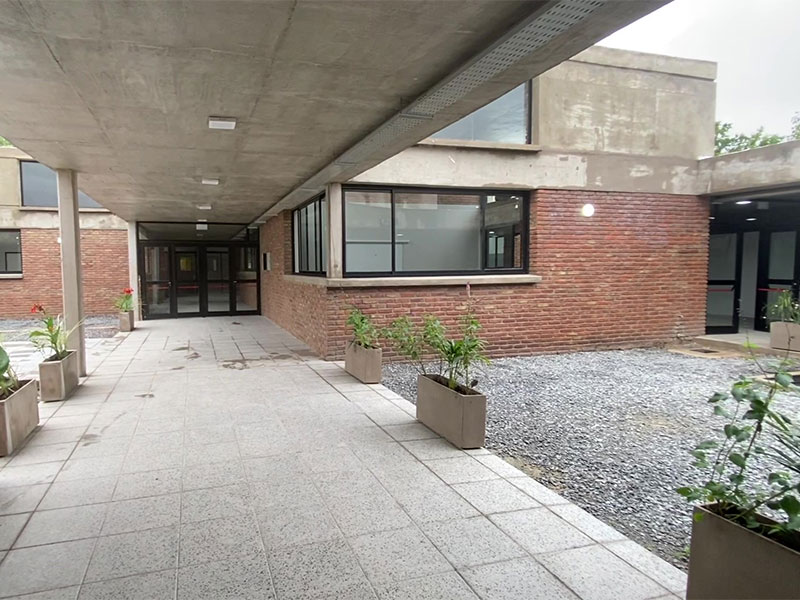Astronomical Ephemeris – January, 2022
Astronomical Ephemeris – January, 2022
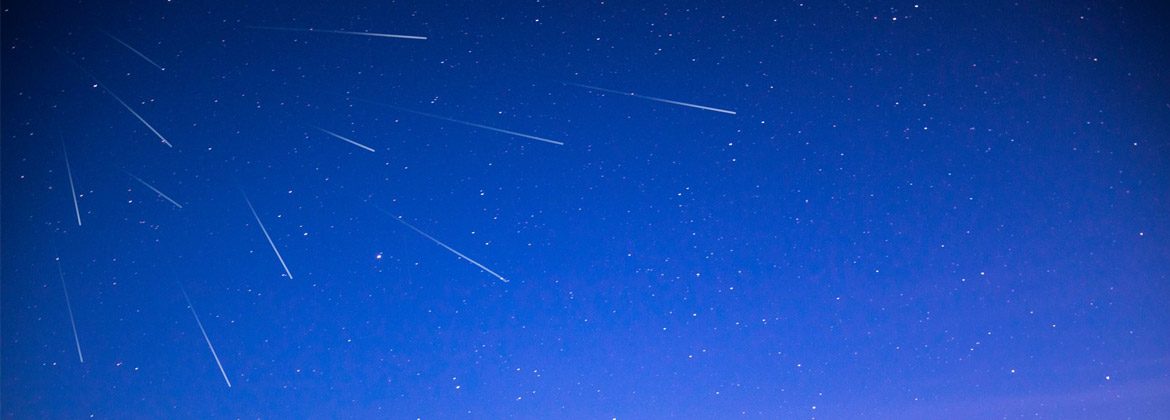

New year, new calendar of astronomical events, the 2022 Ephemeris.
That is, new invitations to direct our gaze to the sky; invitations that are great opportunities to feel the grandeur of the whole and understand the responsibility that involves us for being parts that make up this whole.
Moon phases
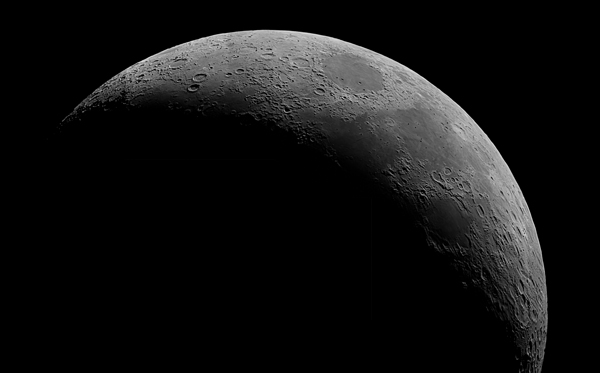
January 2 – New Moon
January 9 – First quarter
January 17 – Full Moon
January 25 – Last quarter
January 2 and 3
Quadrantid Meteor Shower
January opens its calendar of astronomical events observable with the naked eye in the early morning hours of the first days, 2nd and 3rd, with the peak of the Quadrantid meteor shower.
Meteor showers, popularly known as shooting stars, happen because…
Comets and asteroids release large amounts of solid material into space. And the Earth, in executing its orbit around the Sun, ends up passing through these belts of solid materials, which, in turn, enter the Earth’s atmosphere and burn. When this burning happens, the result is what we call a meteor shower.
The asteroid 2003 EH1 is the astronomical object responsible for the Quadrantids – that’s why we call it the Father object – because it’s when the Earth passes through the wake of debris in space left by it that the meteor shower occurs.
Active between December 12, 2021 and January 12, 2022, the Quadrantids produce meteors with short trails that look like small fireballs – a result of their low entry speed into the Earth’s atmosphere, approximately 40 km/sec. They are considered one of the biggest showers because they have a production of 40 to 120 meteors per hour at their peak, that is, when they are most active. It’s also considered the best to observe, especially in the northern hemisphere (in the southern hemisphere it’s less visible due to its celestial latitude).
But don’t expect to see this large number of meteors at their peak – the real average will be about 25 meteors per hour – as this would require a perfectly clear sky with no light pollution. At least the Moon won’t interfere with its great brightness because it will be 0% full on those days.
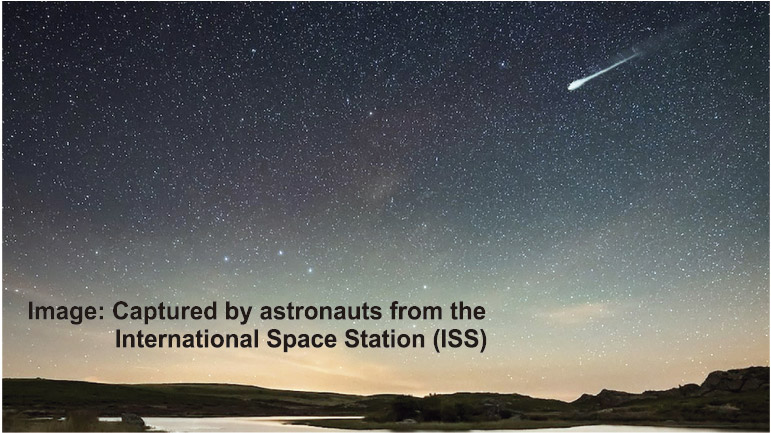
Meteor showers are named after where they appear to originate in the sky – called the radiant point.
However, in the case of the Quadrantids, it’s different. They have their radiant point in the constellation of Boötes, but the name – maintained up to now by historical tradition – comes from an old constellation, proposed by Frenchman Jerome Lalande in the 17th century, Quadrans Muralis (Latin for Mural Quadrant), now defunct.
The best time to observe this event will be the early morning of January 3rd. If you can and want to make this observation, look for a place with little or no light pollution, face the northeast horizon and look up towards the star Arcturus in the constellation Boötes. Let your eyes get used to the darkness and then enjoy the height of this spectacle.
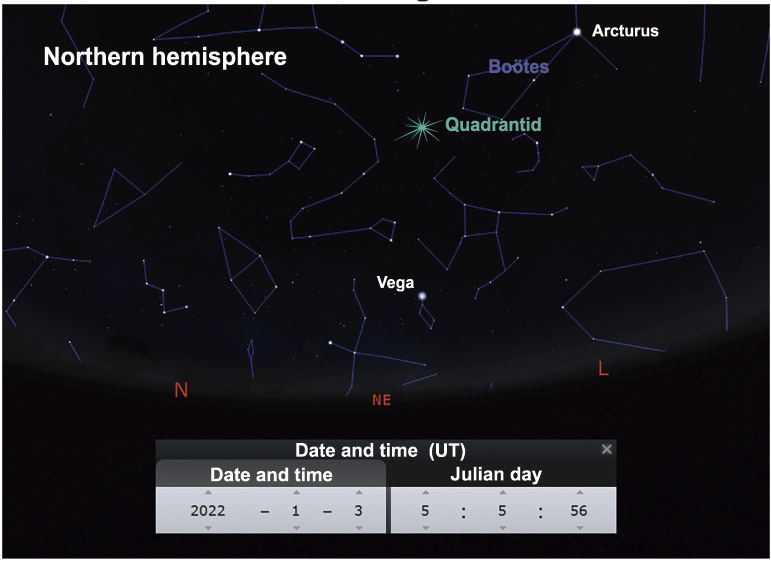
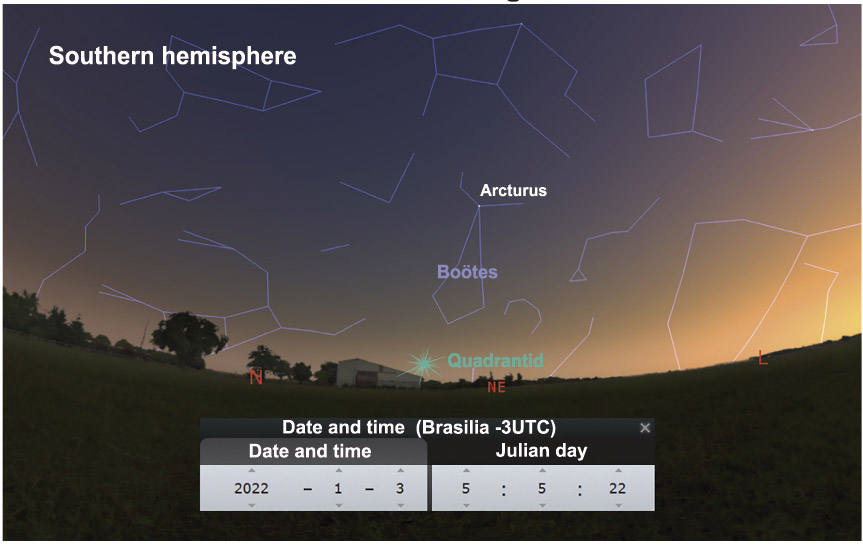
Conjunctions in January
This month, the Moon will help us to locate the planets Jupiter and Mars in the night sky when it forms conjunction with them on the 5th and 29th.
Always remembering that we call a conjunction the perception, according to our field of vision here on Earth, that one or more celestial bodies are very close together in the sky.
Notes:
The angulations and cardinal points mentioned here have the city of São Paulo/Brazil as a reference for the geographic coordinate of the observer’s position.
The Moon and Jupiter as well as the Moon and Mars, despite appearing to be very close together in the sky, will not fit within a telescope’s field of view, so they can only be observed with the naked eye or with binoculars.
January 5
Conjunction between the Moon and Jupiter
The Moon will pass 4°27′ south of Jupiter on that day forming a conjunction with it.
They will be visible to us around 7:15 pm (Brasilia -3 UTC) when they are 33° (angle variable according to the geographic location of the observer) above the horizon in the southwest. Both housed in the constellation Aquarius. They will remain observable in conjunction until approximately 9:15 pm (Brasilia -3UTC) when they will sink below the horizon line.
That day, in our perception, the Moon will apparently shine at a magnitude of -10.7 and Jupiter at a magnitude of -2.1.
Observable around the world.
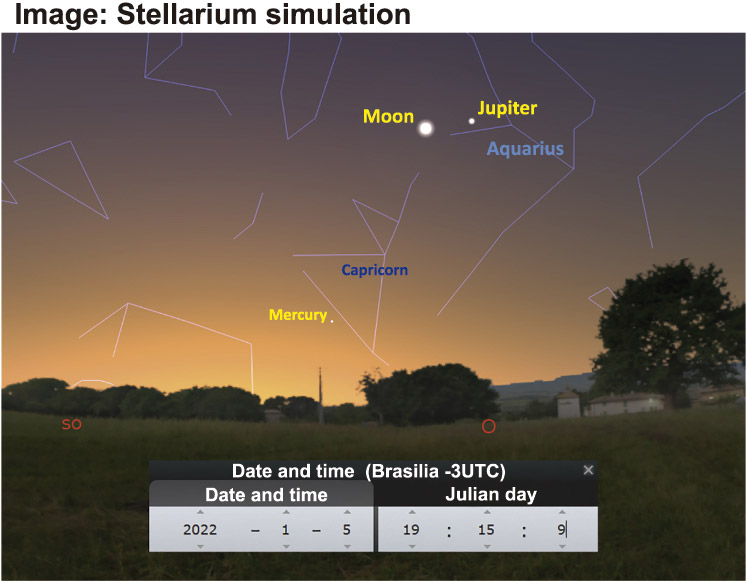
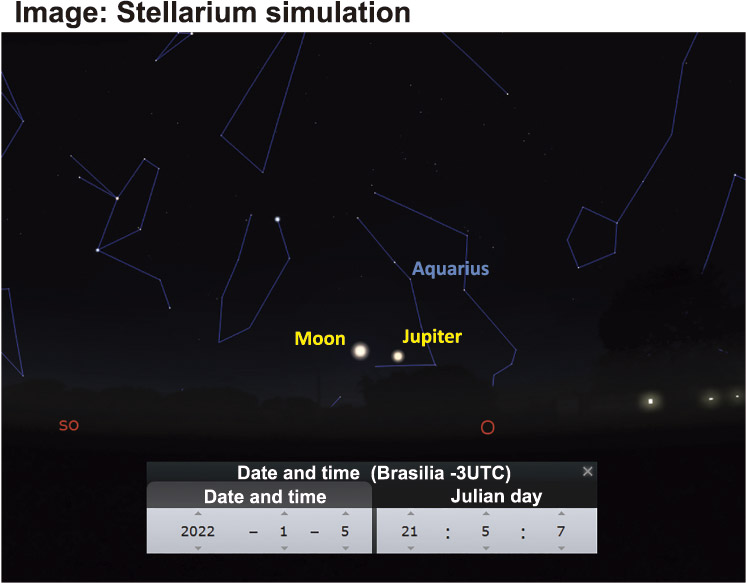
January 29
Conjunction between the Moon and Mars
At dawn on the 29th, it will be the Moon’s turn to form a conjunction with Mars when it passes 2°24′ south of it.
From 3:15 am (Brasilia -3UTC), 30° above the eastern horizon (variable angle according to the observer’s geographic location) the pair can be observed in conjunction, remaining visible until approximately 5:20 am (Brasilia -3UTC), when it will sink below the horizon line. Both will be housed in the constellation Sagittarius.
For us, the Moon will apparently shine at a magnitude of -10.3 and Mars at a magnitude of 1.4 on that day.
Observable around the world.
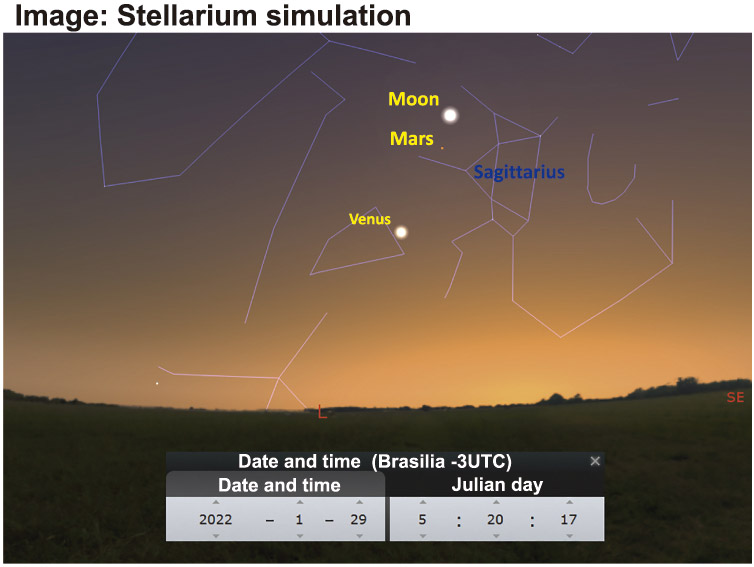
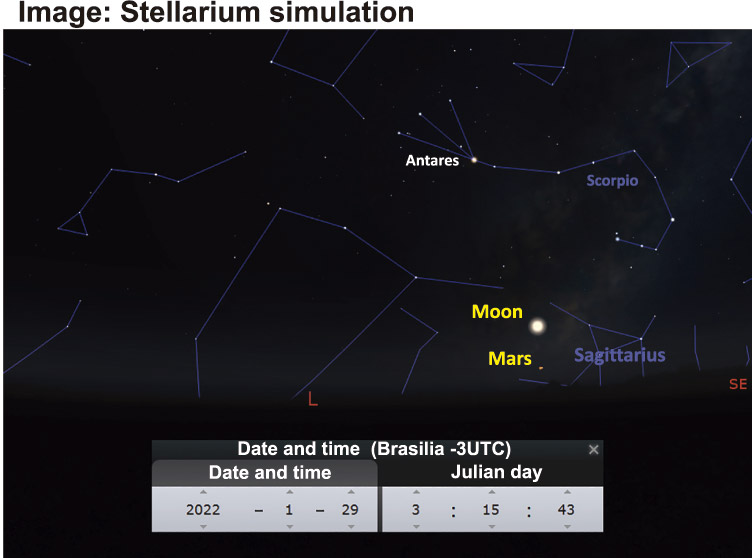
January 7
Maximum elongation of Mercury
First let’s remember that …
In astronomy, the term elongation or stretching of a planet designates the angular separation between it and the Sun, with the Earth as a reference point.
We know that the smallest planet in the solar system, Mercury, has its brightness dimmed by sunlight because it has the closest orbit to the Sun, making it difficult to observe. However, at certain times of the year, in the execution of its elliptical orbit around the Sun, Mercury, when reaching an angular distance from the solar disk so that sunlight does not outshine it, can be better observed. When this happens, we say that it’s at maximum elongation.
On the 7th, Mercury will be at maximum elongation, with an angular separation of 19º to the east in relation to the Sun and with a brightness of -0.6 magnitude. It will be an excellent time to observe it.
To observe this, look toward the western horizon after sunset.
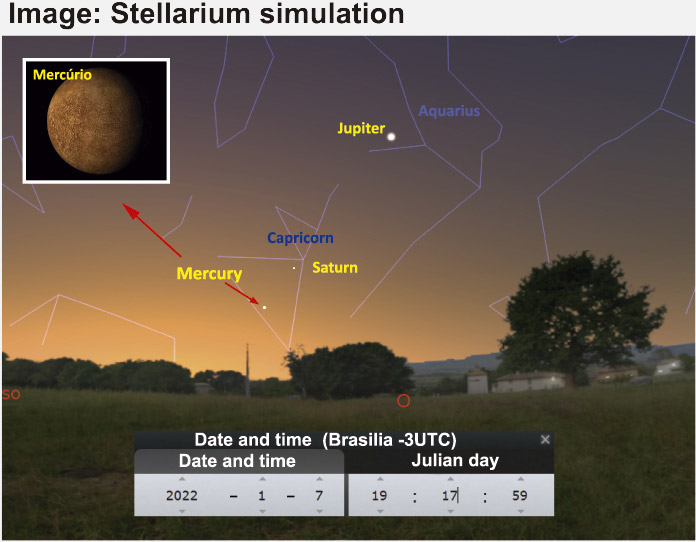
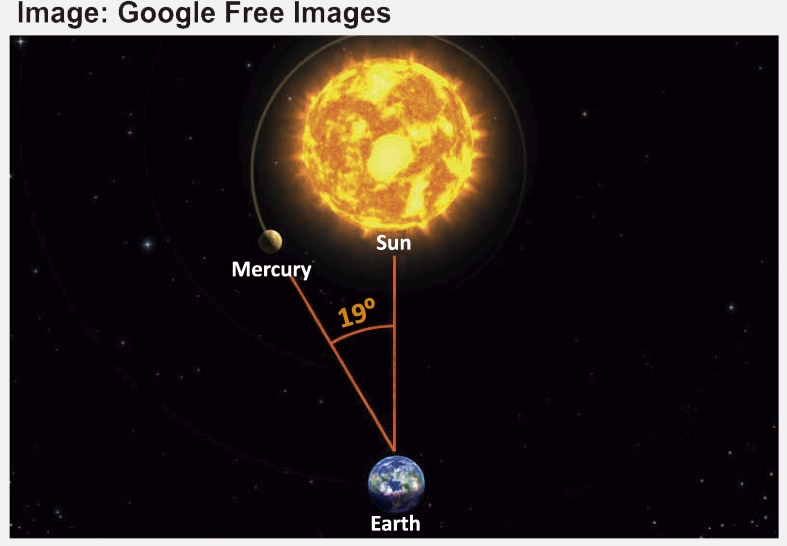
In addition to being at maximum elongation, at that time Mercury will form an alignment with Saturn, Jupiter and the Moon, that is, it will be sharing the same ascending line with them in the sky.
What a beautiful time to observe it!
Observable around the world.
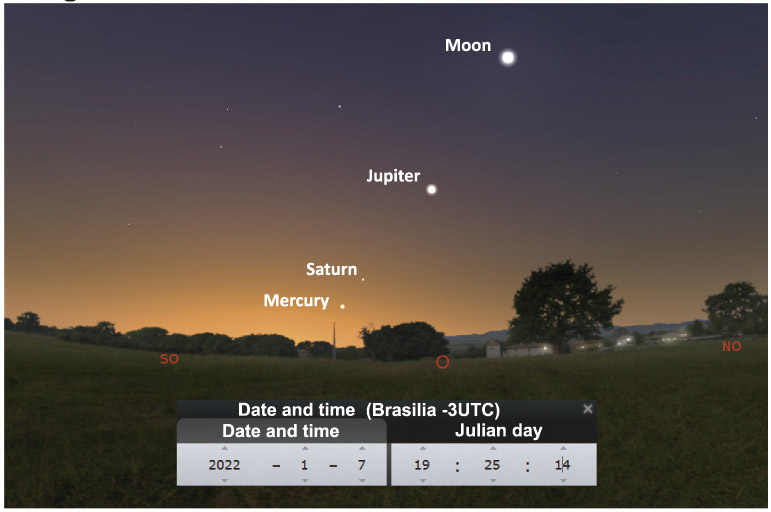
Sources: jpl.nasa.gov/calendar / solarsystem.nasa.gov / in-the-sky.org / Stellarium.org / earthsky.org / derekscope.co.uk / planetary ephemeris – Jet Propulsion Laboratory (JPL) / seasky.org / amsmeteors.org
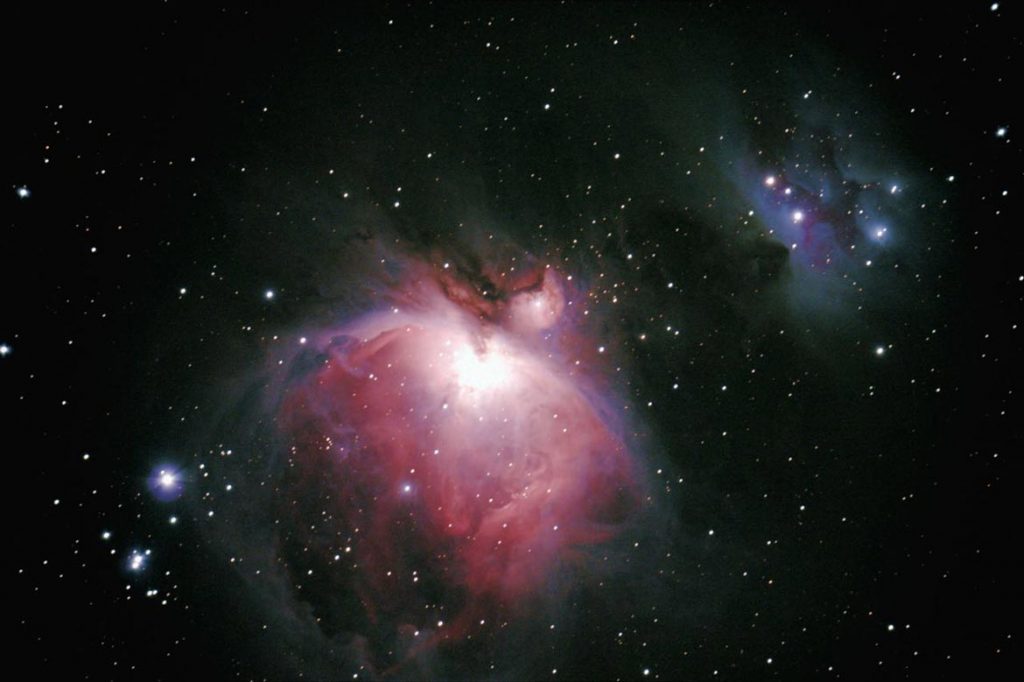
Astronomical ephemerides is a monthly calendar prepared by the Astronomy Sector, which is one of the 12 that make up the PRÓ-VIDA Laboratory Department. In the department, studies, research and scientific experiments related to various themes are developed, as well as field activities and lectures.

Astronomical ephemerides is a monthly calendar prepared by the Astronomy Sector, which is one of the 12 that make up the PRÓ-VIDA Laboratory Department. In the department, studies, research and scientific experiments related to various themes are developed, as well as field activities and lectures.





